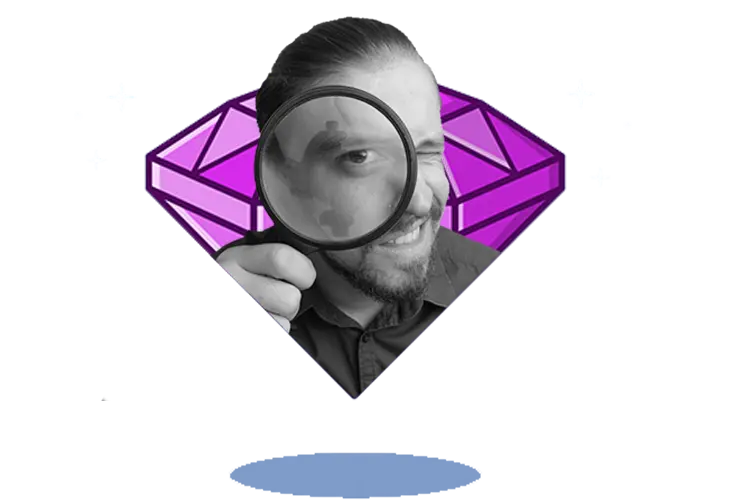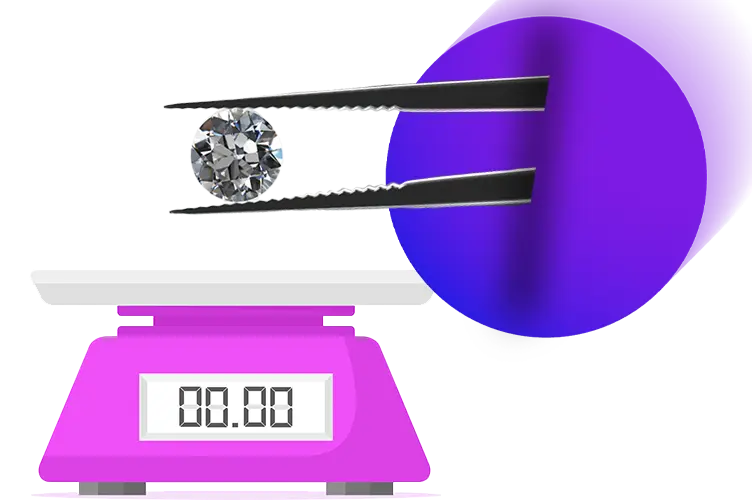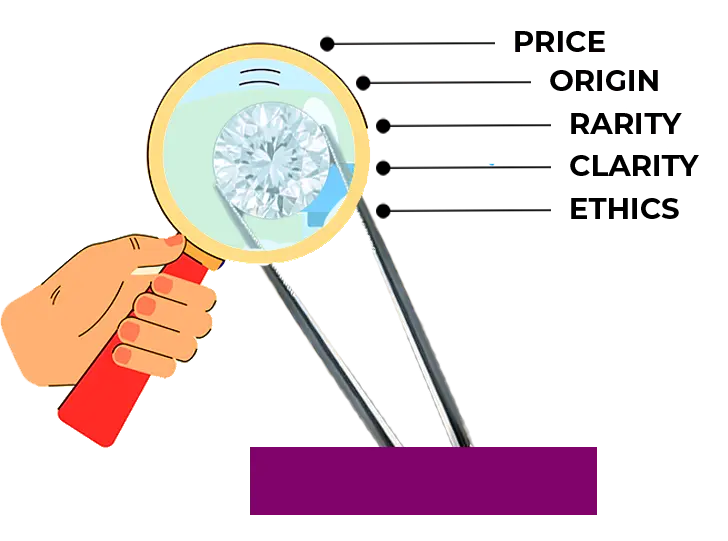
Buying a diamond is a big decision, especially for an engagement ring. Shopping for a diamond ring takes a lot of time and consideration to find the perfect one. A big part of purchasing a diamond is learning its characteristics and structure. Learning about diamonds not only helps you to choose the features that are most important to you, but it teaches you how to spot a real diamond.
Knowing if a diamond is real is especially important if you’re looking to buy a ring second-hand or have a diamond ring that’s a family heirloom. So, let’s look at exactly how to tell if a diamond is real or fake.
If you want to determine if a diamond is real, you can do a few things at home, even without the specialized equipment a diamond expert might use.
Here are six ways to test if a diamond or diamond ring is real at home:

Do real diamonds reflect a rainbow? A real diamond will distinctly reflect light, giving off a gray or white color with some rainbow colors. However, if the reflection shows a rainbow of colors or dull colors, it may be a fake diamond. A real diamond does not reflect a pure rainbow as vibrant as a fake diamond might.
Perform a UV test by putting the diamond or fake diamond under a UV light. Most diamonds emit a blue glow. However, not all diamonds will, so if it doesn’t, that won’t necessarily mean it’s not a real diamond.
If it appears you have a flawless diamond, it may not be real. Real diamonds are not perfect, and they often have imperfections called inclusions. Use a magnifying glass to look for these inclusions – or a jeweler can use a loupe.
Hold the diamond in front of your mouth and breathe on it; a light fog will appear due to the heat and moisture from your breath. This fog will disperse quickly. A real diamond will not retain the fog because diamonds are efficient heat conductors. However, a fake diamond will hold onto the fog for a few seconds.
If you have loose diamonds, you can use the water test. Drop the diamonds into a glass of water; if the diamond sinks, it’s likely real. If it floats at the surface or near the surface, it’s probably fake. Diamonds sink because of the density, but the test will not work for set diamonds because the metal will cause the diamond ring to sink regardless of whether or not the diamond itself is real.
Because of their hardness, diamonds can scratch glass. The Mohs scale is a scientific measurement of the hardness of various minerals. Glass is rated 5.5 on the Mohs scale. Diamonds are a 10 as the hardest mineral. So, if you have loose diamonds and a piece of glass you don’t mind getting scratched, you can perform a scratch test.
However, numerous other minerals will also scratch glass based on their hardness; for example, quartz (7), cubic zirconia (8), and moissanite (9.25). So, this is not a definitive test of whether a diamond is real.
Real diamonds have a specific gravity of 3.52, which means they are heavier than most other stones of the same size. If the diamond you are examining weighs the same as a similar-sized stone, it may not be real.
It’s important to note that some high-quality fake diamonds can pass some of these tests, so it’s always best to consult a reputable jeweler or diamond expert for an accurate assessment. A jeweler likely has a diamond tester that can detect a diamond’s thermal conductivity, which is different from other stones.

Lab-grown diamonds, also known as man-made or synthetic diamonds, are created in a laboratory using advanced technological processes that simulate the natural diamond formation process. These diamonds are made of the same material as natural diamonds – pure carbon – and have the same chemical, physical, and optical properties as real diamonds.
Creating a lab-grown diamond involves replicating the high-pressure and high-temperature conditions deep within the earth’s mantle, where natural diamonds are formed.
There are two main methods for creating lab-grown diamonds:
Lab-grown diamonds are becoming increasingly popular as an alternative to natural diamonds.
The main difference between real diamonds and lab-grown diamonds is their origin. Real diamonds are formed naturally deep within the earth’s mantle. In contrast, lab-grown diamonds are created in a laboratory using advanced technological processes that simulate natural diamond formation.

Here are some other key differences between real and lab-grown diamonds:
A few stones resemble diamonds, so learning how to spot diamonds and these other stones is essential
Cubic zirconia is a synthetic gemstone; it can be identified by its lack of brilliance and fire compared to a diamond. It also has more rainbow-colored flashes than a diamond and is heavier than a diamond of the same size. Due to its density being higher than water, cubic zirconia will typically sink in water, just like a natural diamond would.
White sapphire is a natural gemstone often used as a diamond substitute. It can be identified by its lack of fire and brilliance compared to a diamond. White sapphire is also usually lighter in color and has fewer rainbow-colored flashes.
White topaz is another natural gemstone that resembles a diamond. However, it is usually less brilliant and has less fire than a diamond. It also tends to be more transparent and has fewer rainbow-colored flashes.
Moissanite is a synthetic gemstone; it can be identified by its high brilliance and fire, which can sometimes even surpass that of a diamond. However, it tends to have a gray or greenish tint under certain lighting conditions, which can help distinguish it from a diamond. Moissanite also can exhibit a rainbow-like effect.
Some people want to stick to a diamond engagement ring because of tradition or significance. Still, more and more people are choosing alternative stones. These are the most common reasons for selecting another stone over a diamond engagement ring.
Remember, there’s nothing that says your engagement needs to be a diamond, and there’s nothing wrong with straying from tradition.
Not everyone loves diamonds, and some people prefer the look of a different gemstone. Choosing a gemstone that reflects your style and taste can make the ring more meaningful and memorable.
Diamonds are the traditional choice for engagement rings, but choosing a different gemstone can make the ring stand out and feel more unique. It can also be a conversation starter and a way to showcase individuality.
Many gemstones have specific meanings and symbolism associated with them. Choosing a gem with a particular meaning or significance can add depth and emotion to the engagement ring.
Gemstones other than diamonds can often be less expensive, making them a more affordable option for engagement rings. This can allow you to choose a higher quality or larger stone without breaking the bank.
Some people may prefer to choose a gemstone other than a diamond for ethical or sustainability reasons. Choosing an ethically sourced or lab-grown gemstone can help ensure the engagement ring is environmentally and socially responsible.
Using a diamond or another gemstone for an engagement ring depends on personal preference and priorities. There are many beautiful and meaningful gemstones; the right one will depend on the individual’s tastes, values, and budget.
The Mohs scale is a scientific measurement of the hardness of various minerals. Glass is rated 5.5 on the Mohs scale. Diamonds are a 10 as the hardest mineral, so they can scratch glass. That being said, numerous other minerals; for example, quartz (7), , moissanite (9.25),and cubic zirconia (8), will also scratch glass based on their hardness.
On average, an engagement ring costs between $5,000 and $6,000. However, prices can differ significantly based on elements like the diamond type, quality, and metal of the band. So, there are ways for a diamond engagement right to be cheaper if you’re willing to compromise. Learn more here.
Yes! Not only are lab-grown diamonds just as beautiful, but they’re eco-friendly and sustainable. Plus, it will save you money.
When looking at diamonds, you’ve probably heard of the 4 C’s; this refers to the characteristics of a diamond that determine its quality and value. The four C’s are cut, clarity, color, and carat weight. Using the 4 C’s, and specifically the carat weight, an individual can tell how big a diamond is.
The more you know about diamonds, the more likely you are to find a quality diamond on a budget, but you might have to do some shopping around. The short answer is yes, you can find a beautiful diamond on a budget; however, you may want to consider alternative options such as lab-grown diamonds or even an alternate gemstone.
Now that you know more about diamonds and how to tell if they’re real, you can decide if a diamond engagement ring is right for your partner or find the most flawless diamonds that will suit your budget.
At The Groom Club, we help the groom-curious and grooms up their game at every stage! If you’re ready to propose and don’t what to do, we’ve got tips! Want to learn more about engagement ring history and symbolism? We’ve got your back.
Make The Groom Club your go-to spot for all the latest on how to make your wedding unique and memorable. Discover all our latest articles today and subscribe to our newsletter for more TGC content. Cheers!